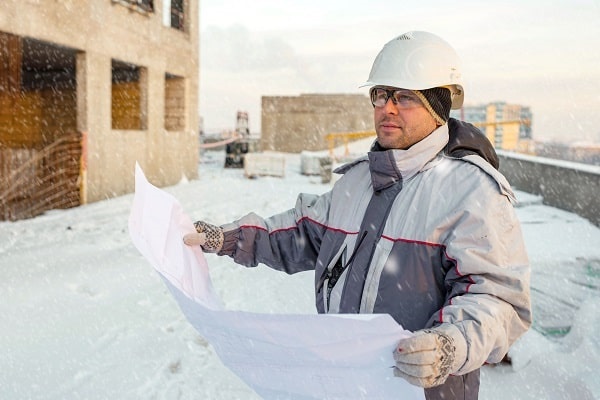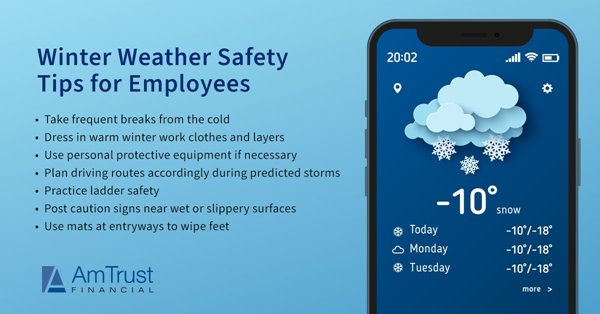Summary: Working in winter weather conditions can be risky - or even fatal - for employees. Learn more about the common workers' compensation claims filed in the winter months, and discover winter weather safety tips employers can implement that could lower the risk of injuries for outdoor workers. Winter Safety Tips for Working Outside
Winter can be a tough time of year for workers in many parts of the country. Combine low temperatures with high amounts of snowfall or icy conditions, and working outdoors becomes a challenge to even the most seasoned employee.
Winter injury statistics from the Bureau of Labor Statistics (BLS) found there were over
20,400 employee injuries caused by ice, sleet or snow, with 14% of those injuries occurring just in the state of New York. Additionally, between 2016 and 2020, ice, sleet or snow caused a total of
139 fatalities. The
types of injuries reported include sprains and strains, fractures, bruises and contusions, which makes sense when you consider the high number of slips and falls caused by slick or icy walkway conditions. Additionally, the frigid air can also bring a variety of cold stress injuries and illnesses for outdoor workers exposed to the elements.
Common Workers’ Comp Claims in Winter Weather
Understanding the
risks employees working in cold weather face can be critical to avoiding injuries and illnesses throughout the winter. Similar to employees who work outdoors during the
summer months, workers in various industries, such as construction or utility workers and first responders, all can face common
winter weather hazards.

Here are some of the most common workers’ compensation claims filed in the winter months:
Cold Stress Illnesses
Prolonged exposure to low or freezing temperatures can cause a variety of cold-related illnesses, including:
- Frostbite: Frostbite occurs when the skin and tissue, most often fingers, toes, earlobes and noses, have been exposed to freezing temperatures. It can permanently damage body tissues and in extreme cases, it can lead to amputation.
- Hypothermia: Workers who are outside for long periods can start to lose heat faster than it can be produced, which uses up the body’s stored energy and results in abnormally low body temperature. In the early stages of hypothermia, a worker may shiver and exhibit loss of coordination, confusion and fatigue. Later, they could lose consciousness as the pulse and breathing continue to slow down.
- Trench Foot: This injury, also known as immersion foot, occurs when feet have been exposed to wet and cold conditions for an extended time. Body heat begins to escape through the feet quickly when they are wet, and this can occur even in water of 60 degrees. Trench foot symptoms include reddening of the skin, numbness, cramps, tingling, swelling or blisters.
Workers with cold-stress illnesses could face costly hospitalization or medical bills, or even life-changing amputations that could alter their ability to work in the future. These types of injuries could lead to filing for workers’ compensation benefits to help cover the costs for lost wages and medical expenses.

Muscle strains, sprains and fractures
Slip and fall injuries like muscle strains, sprains and fractures tend to increase throughout the winter months, often due to workers slipping on icy
sidewalks, slick spots in entryways or
parking lots not properly cleared of snow. The
CDC reports that the medical and workers’ comp expenses associated with occupational fall incidents have been estimated at $70 billion in the United States. Property owners will see an increase in workers’ comp claims or claims for negligence if an employee slips and falls, especially if a reasonable or preventable action, like applying salt or
hiring a snowplow company, could have been taken to address the situation before the injury occurred.
Driving in winter weather
Road conditions are often hazardous in the winter, and icy, snowy or slushy roads are responsible for
24% of all weather-related vehicle crashes. Drivers can be in a rush to get to their destinations on time, or they may not feel confident in their
winter driving skills. Combine slick road surfaces along with poor visibility or driver error, and it’s easy to understand why there could be an increased number of vehicle accidents in the winter. More accidents, in turn, means workers’ comp claims for drivers or off-site employees also can increase throughout the colder months.
Snow shoveling or snowblowing injuries
Keeping walkways and driveways clear of snow and ice is vital to keeping employees, customers, vendors and other visitors safe. However,
shoveling heavy, wet snow can easily lead to a variety of lower back injuries, as well as muscles, tendons and soft tissue injuries, broken bones, head injuries and heart-related issues. Plus, snowblowing has its own injury risks, like cuts, lacerations and even amputations. It’s recommended that companies hire a
reputable snow removal company to help keep parking lots and walkways safe throughout the winter months and to help reduce workers’ compensation claims for the injuries these tasks could cause.
Working on rooftops
Keeping
rooftops clear of heavy snow and ice is important to prevent damage to your building. However, workers tasked with clearing that snow face a variety of risks that could lead to a workers’ compensation claim. A roof could be structurally unsafe due to the weight of the snow and ice covering it. Plus, workers may be unaware of skylights and other increased risks, like slippery surfaces or overhead power lines. Falls from these heights is a major concern throughout the entire year, but especially so during the winter months when clearing rooftop snow could lead to a catastrophic slip and fall. It’s recommended to leave this task to the experts who have the proper experience and equipment, like aerial lift systems and related tools, for the snow removal process. These experts also know details such as the anchor points on the roof structure for proper tie-off, which helps reduce or eliminate a fall exposure.
Cold Weather Safety Tips for Workers

A few
general safety tips to keep in mind for outdoor workers this winter include:
- Ensure employees take frequent breaks from working in freezing temperatures in a warm, dry shelter
- Encourage employees to dress in warm winter work clothes and layers, including an inner layer that can absorb moisture
- While there is no OSHA requirement to provide workers standard winter clothing items like coats, gloves, rubber boots, hats, etc., if workers spend a great deal of time outside, providing these items will not only protect them from the weather but also help improve the company safety culture by showing workers that their well-being is of high importance
- For employees who must work in unusually severe weather conditions, employers are required to provide personal protective equipment and clothing such as anti-exposure work suits, insulated work gloves, winter liners for hard hats, UV protectant sunglasses, waterproof boots and mouth/face coverings
- Stay ahead of the weather to watch for potential storms and plan driving routes accordingly
- If employees need to access the roof using a ladder, ensure they utilize a fiberglass ladder, securely fastened at the top of the point of access, that they are tied off and that two employees are performing the task: one on the ladder and a spotter on the ground
- Post caution signs near wet or slippery surfaces to warn employees about potential slip and fall hazards
- Replace mats at entryways when they get saturated or begin to curl at the edges

Reduce Risk this Winter with Loss Control Services from AmTrust Financial
Your employees’ safety is important the whole year through. AmTrust’s
Loss Control Department offers a variety of
winter safety resources to protect your employees and your business from the various risk the season brings. For more information, please
contact us today.
This material is for informational purposes only and is not legal or business advice. Neither AmTrust Financial Services, Inc. nor any of its subsidiaries or affiliates represents or warrants that the information contained herein is appropriate or suitable for any specific business or legal purpose. Readers seeking resolution of specific questions should consult their business and/or legal advisors. Coverages may vary by location. Contact your local RSM for more information.